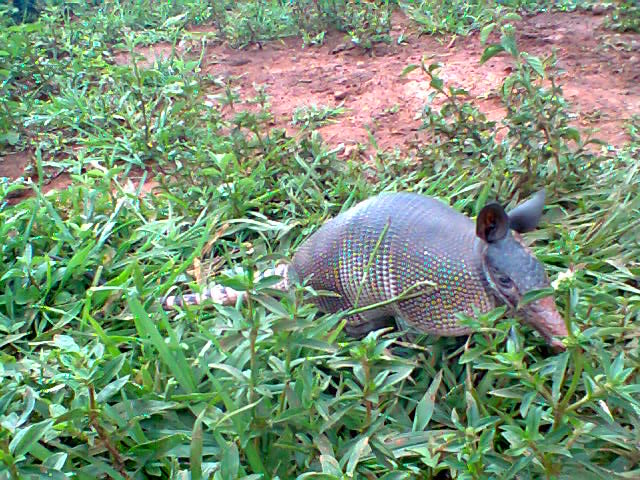Armadillos are to be found throughout the Paraguayan countryside. Despite being elusive and difficult to see in the wild they are quite common.
Armadillos in Paraguay a hard to spot for the same reason that badgers are in Britain. Like badgers armadillos spend much the day underground in a burrow emerging only at night to forage for food.
Hunting for armadillos in the Paraguayan countryside has a long history. It was the aim of one of the very first nature films made by David Attenborough in the 1950s under the title Zoo Quest Paraguay. His was actually seeking the much rarer Giant Armadillo and although that was unsuccessful he did catch a number of their smaller relatives.
These were Dasypus Armadillo or the Nine Banded Armadillo. The type of armadillos which are far more common in Paraguay.
The Nine Banded Armadillo has a large territorial range. In can be found in the wild in North, Central and all through South America. There are very few habitats to which it is not suited. Principally deserts and high mountains.
It is a medium size mammal with a body approximately 50cm in length and a tail of a similar length. The upper body of an armadillo is made a number of solid interlocking plates. Hence the name Nine Banded.
There need not though be nine plates. The exact number can vary from specimen to specimen and feature more or less than the standard nine bands.
Many species of armadillo are able to roll their body up into a ball to present only their tough plates to a would be predator. The Nine Banded Armadillo however is not able to do this although its soft underside is still concealed. If need be a burst of speed will be used to escape from danger.
Home to an armadillo is its burrow. The armadillo is a solitary creature but even so builds a large burrow with as many as twelve separate entrances. A number of those will be false entrances to deter predators. Others will be positioned to provide for quick entrances and exits from the burrow from various parts of the armadillos range.
Most of the daylight hours are spent by armadillos asleep deep within their burrow. Then after dark the armadillo will emerge to forage for the night.
The diet of an armadillo consists primarily of grubs and insects. In addition to these they will occasionally eat berries, birds eggs or even small lizards.
Being nocturnal most prey is located by its smell. Armadillos have a very good sense of smell.
Living a nocturnal lifestyle vision is less important. Accordingly the vision of armadillos is quite poor.
When I walk though woodlands or the wilder corners of my garden it is not uncommon to come across evidence of armadillos. This is almost always in the form of a cluster or burrows dug into the forest floor surrounded by disturbed earth.
Somewhere below may lie a sleeping armadillo. However as they are such prodigious tunnel diggers the armadillo may have moved on to dig a fresh burrow complex.
These abandoned diggings are not though left to waste. Other creatures the also like to nest below ground but either can’t or would rather leave something else to do the excavating will soon move in. These include amongst other things owls and snakes.
An armadillo in digging far more tunnels than it can use provides ready made homes for other creatures of the woodlands.
Another reason for armadillos to stay out of sight is to avoid the cooking pot. In the Paraguayan countryside an armadillo is considered a delicious treat and a welcome alternative to the usual beef and chicken.
Few though do end up in the pot for armadillos have been experts in evading predators for millions of years. Keeping to their nocturnal lives long before humans arrived in their territories.
As such as long as there remain wild places in the woodlands and countryside the armadillos will continue to flourish.


Interesting reading